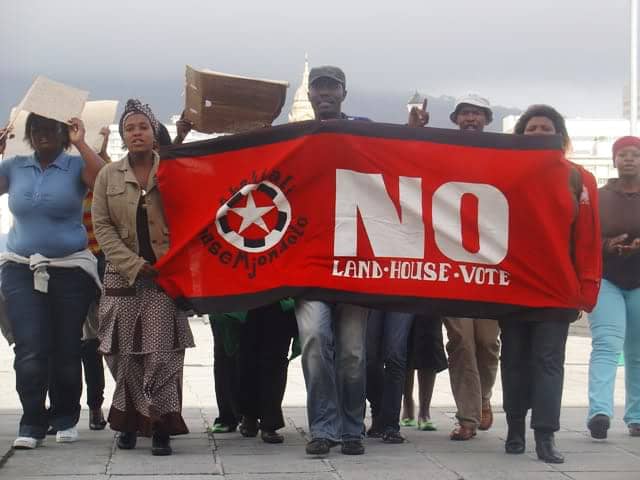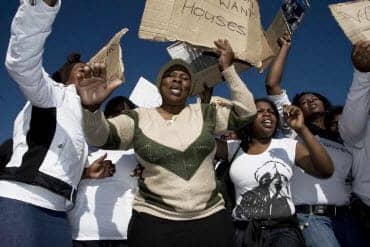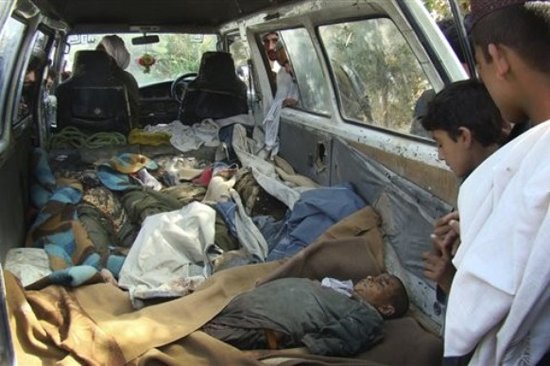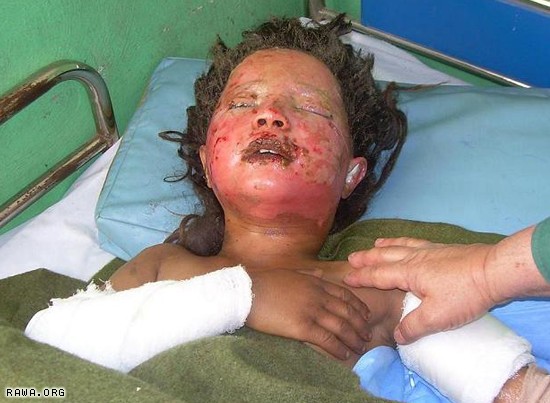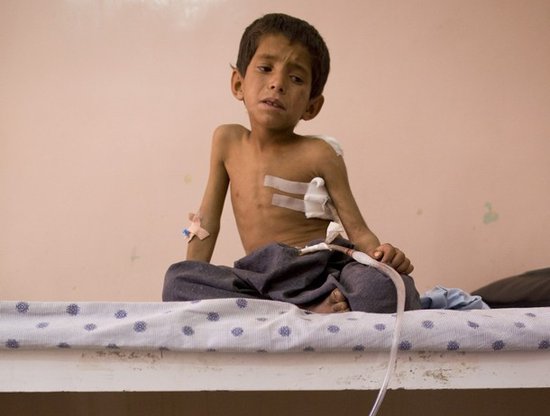 I get sick and tired of posting stuff about men and women being held with no justice in America's prisons, but the truth is the stories are just too numerous. Herman Wallace is one such man. Herman Wallace should be free.
I get sick and tired of posting stuff about men and women being held with no justice in America's prisons, but the truth is the stories are just too numerous. Herman Wallace is one such man. Herman Wallace should be free.
The following is from Infoshop News.
Southern Injustice: Herman Wallace of the Angola
By James Ridgeway and Jean Casella
Mother Jones
For the better part of four decades, Victory Wallace, 70, has made a monthly trip from New Orleans to the Louisiana State Penitentiary at Angola to visit her brother Herman, who just turned 68. The 140-mile journey has shades of Heart of Darkness, following the course of the Mississippi River to a remote prison colony from which most inmates never return. At the dark heart of this former slave plantation, Herman Wallace has lived most of the past 37 years in solitary confinement, imprisoned alone for 23 hours a day in a 6-by-9-foot cell.
When Herman was moved in the spring of 2009 from Angola to Hunt Correctional Center near Baton Rouge, Vickie's trip got a bit shorter. But what she found when she arrived on her most recent visit was even worse than usual. Because of a disciplinary infraction, Herman had been placed in "extended administrative lockdown." That meant Vickie was denied a contact visit, and was permitted to see her brother only through a glass partition as they spoke over a telephone. His hands were shackled to the table. (Other recent visitors reported that the shackles made it hard for him to hold the phone to his ear, while his hearing loss made communication over the telephone difficult.) Herman complained to Vickie that he was cold, and she thought that he had lost weight. His spirits, she said, were not the best.
For years, Herman Wallace's hopes have ridden on two cases that are inching their way through the courts—one challenging his conviction, the other challenging his long-term solitary confinement. Now, after a decade of starts and stops, obstacles and delays, both cases are advancing toward conclusions that will determine how he spends what's left of his life.
With the exception of a few brief intervals, Wallace has been living in lockdown since 1972, when he was accused of murdering a young Angola prison guard. Along with another inmate named Albert Woodfox, he was tried, convicted, and sentenced to life without parole. Wallace, Woodfox, and a third longtime prisoner called Robert King—who are known as the Angola 3—are also plaintiffs in a federal lawsuit alleging that their unparalleled time in solitary violates the constitutional ban on cruel and unusual punishment. The case [1]—which could potentially affect the estimated 25,000 American prisoners living in long-term lockdown—is expected to come to trial in the US District Court in Baton Rouge in early 2010.
Since 1990, Wallace has also been appealing his criminal conviction in the Louisiana state courts. He believes that he was targeted for the guard's murder because of his involvement in Angola's chapter of the Black Panther Party, which had been organizing against conditions in what was then known as "the bloodiest prison in the South." Wallace contends that the prosecution's witnesses—all of them fellow Angola prisoners—were coached, bribed, coerced, or threatened into giving false testimony against him by prison employees bent on revenge. "If they could have hung and burned the guys involved they would have," one inmate witness later told Wallace's lawyers. "But there was too much light on the situation." Documents and testimony that have surfaced since the trial show that prosecutors knew a good part of their case was unreliable or manufactured. The state's own judicial commissioner, assigned to study the case in 2006, recommended that Wallace's conviction be overturned. Even the prison guard's widow has publicly stated that she now doubts [2] the guilt of the two men convicted of her husband's murder, and still wants to see his killers brought to justice. But the Louisiana courts, one after another, have rejected his appeal, providing no reasons for their decisions.
Now, Wallace has turned to the federal courts. On December 4, he filed a petition for a writ of habeas corpus—basically, a plea for a reversal of his wrongful conviction. It is his last chance to win a new trial, and possibly his freedom. On his side are a team of skilled pro-bono attorneys who have assembled a brief full of evidence that was hidden or suppressed 35 years ago during his original trial. Against him is an increasingly conservative federal court system, along with two of the most powerful figures in Louisiana criminal justice: Angola's famous warden, Burl Cain, and the state's ambitious attorney general, James "Buddy" Caldwell, both of whom appear determined to fight to the bitter end to ensure that Herman Wallace never again sees the light of day.
The incident that condemned Herman Wallace to a life in lockdown took place at a particularly explosive time in Angola's notoriously violent history. In the early 1970s, Louisiana's 5,000-man penitentiary was the nation's largest prison; it was also notorious for its high rates of murder, rape, and assault. The former slave plantation's 18,000 acres were farmed by prisoners working up to 96 hours a week, overseen by armed inmate guards, known as "trusties." The trusties also oversaw gambling, drug-dealing, and a monstrous system of sexual slavery—sanctioned by some of the all-white corrections officers, who were referred to by staff and inmates alike as "freemen."
"Angola in those days was life and death, buying and selling people, and the officers knew it was happening," Howard Baker, a prisoner who testified at Wallace's trial, stated in a subsequent affidavit. "There was a goon squad of guards. If they came after you, you could get anything from a beating to being killed, and they'd call it being killed by trying to escape." In addition, Baker said, "Physical conditions were about as bad as you can get: hot, dirty, overcrowded. Weapons were everywhere. You could shake down for weapons one night and have just as many the next. I saw as many as four stabbings a week, week after week."
It was also a time of simmering tensions between longtime employees—many of whom had grown up in the staff community on the prison's grounds—and Angola's new "reformist" leadership. A few years earlier, Warden C. Murray Henderson and Deputy Warden Lloyd Hoyle had been brought in from out of state to "clean up Angola." As Wallace's habeas petition states:
Their arrival at Angola disrupted [the Louisiana State Penitentiary's] existing leadership, most of whom had worked their way up the ranks at Angola. Associate Warden Hayden Dees and the old-guard leadership notably resisted their reform efforts, particularly those aimed at ending racial segregation and those directed at according inmates in extended lockdown, known as CCR (closed cell restriction), with due process. Associate Warden Dees in particular believed that "a certain type of militant or revolutionary inmate, maybe even a communist type," should remain under lockdown conditions at all times; he wanted nothing to do with documenting decisions about who went into lockdown and for how long in compliance with federal court requirements.
Among the "militant" inmates were Herman Wallace and Albert Woodfox, both serving time for armed robbery. After they arrived at Angola they became active members of the prison's chapter of the Black Panther Party. This cadre of inmates organized petitions and hunger strikes to protest the horrendous conditions at the prison, and helped new inmates, known as "fresh fish," protect themselves from sexual assault and enslavement. For their efforts, some of the Panthers were placed in solitary confinement to suppress what was viewed as a threat to prison authority.
On April 17, 1972, 23-year-old guard Brent Miller was found in front of an inmate dormitory, stabbed 32 times. Investigators initially had no suspects, but they soon zeroed in on the activists. In a written description [3] [PDF] of his case, Wallace stated that Hayden Dees, the associate warden, "went well out of his way to tie us in with the death for his own political gain. He claimed that Henderson and Hoyle were responsible for Miller's death by releasing the 'militants' (he linked me and Woodfox to those released)."
Statements from Henderson and Hoyle confirm that some of the guards considered them complicit in the killing. Three days later, Lloyd Hoyle, the deputy warden, was called from home to a meeting of staff members, who accused him of turning loose Miller's murderers. Hoyle was assaulted and pushed through a plate glass door, and nearly bled to death before one of the guards decided to drive him to the hospital.
Wallace was thrown into lockdown the day of Brent Miller's murder. Within a few days, officials had obtained the evidence they needed to charge Wallace and three other so-called "militants"—Woodfox, Chester Jackson, and Gilbert Montegut—with the crime. They were indicted by an all-white, all-male grand jury in nearby St. Francisville, Louisiana, which was home to many prison staff, their families, and friends.
A river town near the Mississippi border, St. Francisville proudly advertises itself as plantation country. It was also Klan country, and until the civil rights movement and the FBI arrived in the early 1960s, no African American had registered to vote in the parish in more than 60 years. The defendants in the Miller case contested the indictment on the grounds that women and blacks had been systematically excluded from the jury pool. They were subsequently re-indicted by another grand jury, chosen through "the same or substantially the same grand jury selection procedures," according to Wallace's current brief.
Albert Woodfox was convicted of Miller's murder in a separate trial in 1973. After being granted a change of venue, the three remaining defendants—Wallace, Jackson, and Montegut—stood trial in East Baton Rouge in January 1974—before yet another all-white, all-male jury. The prosecutors in the case presented no physical evidence to tie the three men to the crime. Although bloody fingerprints had been found near the guard's body, they matched none of the defendants'. According to evidence presented in Wallace's petition, no effort was made to match them to any of the 5,000 other inmate prints on file. A bloody knife, likewise, could not be connected to any of the men on trial. The evidence against them consisted entirely of testimony by other Angola prisoners obtained under highly dubious circumstances.
The prosecution's star witness was Hezekiah Brown, whose eyewitness testimony was indispensible to its case. An aging prisoner serving a life sentence for aggravated rape, Brown said that he had been in the dormitory on the morning of Brent Miller's death, and had seen the defendants stab the guard repeatedly. Former Angola prisoners have said in interviews that Brown was a notorious snitch. But it would be nearly 25 years before proof emerged [4] showing just what happened behind the scenes to secure his testimony.
In 1998, lawyers for Wallace's co-defendant, Albert Woodfox, succeeded in obtaining previously suppressed witness statements, taped interviews, and other documents from the murder investigation carried out by prison officials, the county sheriff's office, and local prosecutors. These materials, supplemented by testimony by Warden Henderson and others, show that Hezekiah Brown was encouraged, if not coerced, to identify the prisoners already chosen as suspects. Henderson admitted he promised to seek a pardon for the lifer if Brown helped them "crack the case." A series of letters to judges, pardon board members, and the secretary of corrections shows that Warden Henderson kept his word, though it would be more than 10 years before Brown's pardon came through. In the meantime, Brown benefitted from an array of special favors, including reassignment to a private room at the low-security "dog pen" where the prison's bloodhounds were trained and a carton of cigarettes, the crucial prison currency, every week.
Another inmate witness, Joseph Richey, placed Wallace and the others at the scene of the crime; he was later found to be a schizophrenic who was heavily medicated with Thorazine. After the trial, Richey was transferred to a plum job at the governor's mansion and given weekend furloughs (during which he robbed several banks). Previously suppressed documents, obtained through the discovery process by Albert Woodfox's lawyers in 1998, show that Angola officials didn't believe Richey had seen anything. The state possessed these documents at the time of Wallace's trial, and presented his possibly perjured testimony nonetheless.
Howard Baker, yet another prisoner who testified at Wallace's trial, has since sworn an affidavit completely recanting his testimony. Baker had initially been a suspect in Miller's murder, and may have been seeking to protect himself. In the affidavit, Baker states:
So I looked at the situation like this, I got 60 something years, and I got a chance to help myself – so I was going to do something to help me get out of this cesspool….So, I gave a statement on 10/16/72, to Warden Dees, which was a lie. And my testimony based on that statement was a lie. I really thought this would help me because Dees told me my statement would get my sentence commuted….It was all over the penitentiary that they [Wallace and Woodfox] were the ones that administration thought was involved. So I gave a statement.
The state played its ace-in-the-hole in the middle of the trial, when one of the four co-defendants walked in after a recess and sat down at the prosecution's table. Chester Jackson had turned state's witness, and would now testify against the others. The defense attorney, Charles Garretson, later testified that he "was in a complete state of shock…it took everything I could glean together to maintain professionalism and sanity and intelligence to go forward after this lunch break." The court gave him less than 30 minutes to prepare to cross-examine his own former client. Although he denied it on the stand, Jackson had clearly cut a deal; shortly after the trial, he would plead guilty to manslaughter. Garretson later said that he felt he was "the only one in the courthouse that didn't know this. I felt that—I know all the deputies knew it. I felt the judge knew it."
These allegations of widespread and deliberate suppression of evidence form the core of Herman Wallace's current appeal. His habeas petition states, "Mr. Wallace's defense strategy was to show that the State's inmate witnesses must be either mistaken or lying. Although the State possessed precisely the information Mr. Wallace's defense counsel sought—material which would show that the State's witnesses lacked credibility and the State's prosecution lacked integrity—the State disclosed none of it." This withholding of evidence, Wallace says, violated his constitutional right to due process.
Wallace's remaining co-defendant, Gilbert Montegut, had a prison guard to confirm his alibi, and was acquitted. Herman Wallace was convicted of the murder. His conviction happened to fall during a brief period when the Supreme Court had effectively struck down capital punishment—had it come at any other time, Wallace would likely have received a death sentence. Instead, he got life without parole and was placed in lockdown, along with Woodfox. The reason given for their confinement in solitary was the nature of the crime—the murder of a guard, which rendered them a threat to others in the prison community. Both Wallace and Woodfox remain there, ostensibly on the same grounds, 35 years later.
If the story of Herman Wallace's trial reads like a study in Southern justice, its sequel shows what has changed in Louisiana in the intervening decades—and what has remained the same. Wallace and Woodfox now have a small legion of active supporters and an impressive team of lawyers renowned for their death penalty appeals, including Nick Trenticosta, director of the Center for Equal Justice, in New Orleans, and George Kendall at the pro bono unit of Squire Sanders & Dempsey in New York. But even good lawyers can't vitiate the Louisiana justice system's apparent determination to keep Wallace and Woodfox locked up and locked down, for reasons that appear to go far beyond the facts of the 1972 murder of Brent Miller.
The two men believe that they were originally targeted for the murder because their political beliefs and activism represented a threat to the absolute power of prison authorities. Statements from Angola's current warden, Burl Cain, suggest they are being kept permanently in solitary for much the same reason. Cain has been widely celebrated [5] for "transforming" Angola, largely through the institution of Christian "moral rehabilitation," which he sees as the only path to redemption for the sinners in his charge. There is no room, either in Cain's worldview or on his prison plantation, for people who question authority like Herman Wallace and Albert Woodfox have.
In a 2008 deposition, Cain declared, "The prison operates with one authentic authoritarian figure, the warden and the rule book." He also said that Woodfox's lack of deference made him a dangerous man: "The thing about him is that he wants to demonstrate. He wants to organize. He wants to be defiant. He wants to show to others that he is powerful and strong."
Woodfox's lawyers have pointed out that he had no record of violence and few disciplinary infractions in the past 20 years. They documented a similar record for Wallace in a 2006 deposition [6] [PDF]: "Mr. Wallace's most recent disciplinary report for institutional violence occurred some 22 years ago," it said, and in recent years, Wallace's handful of infractions included "possessing handmade earrings and a poem, 'A Defying Voice'"; "wearing a handmade necklace with a black fist"; and "possessing the publication, It's About Time, a Black Panther publication 16 containing articles/photos on the Angola three, characterized as, quote, 'racist literature' by security personnel." His most recent disciplinary report "was December 2005, when he was found in the possession of excess number of postage stamps, for which he received thirty days cell confinement."
But Cain believes "It's not a matter of write-ups. It's a matter of attitude and what you are." And to Cain, what Woodfox and Wallace are and will always be is Black Panthers. Associate Warden Hayden Dees previously said that "a certain type of militant or revolutionary inmate, maybe even a communist type" was dangerous enough to be kept in permanent lockdown. In 2008, Cain said that Woodfox belongs in solitary because "I still know that he is still trying to practice Black Pantherism, and I still would not want him walking around my prison because he would organize the young new inmates. I would have me all kind of problems, more than I could stand, and I would have the blacks chasing after them."
Wallace says [7] that Cain at least once offered to release the two men into the general population if they renounced their political views and accepted Jesus Christ as their savior. He refused. Cain declared that "Albert Woodfox and Herman Wallace is locked in time with that Black Panther revolutionary actions they were doing way back when…And that's still their motive and that's still their goal. And from that, there's been no rehabilitation."
Louisiana's attorney general, Buddy Caldwell, also appears determined to keep the two men in prison at all costs—a vow that he will likely try to uphold even if Wallace's case succeeds in federal court. Caldwell's resolve has already been tested in the case of Woodfox: When a federal judge overturned Woodfox's conviction in 2008 and ordered him released on bail, the attorney general sprang into action—filing an emergency motion to keep him behind bars, sending fearmongering emails to the community where Woodfox was planning to stay with his niece, and telling the press that he was "the most dangerous person on the planet." Persuaded by Caldwell's plea and Cain's testimony about his dangerous nature, the federal appeals court granted the motion and denied Woodfox bail; he remains in lockdown, awaiting his appeal. In a recent letter, Wallace wrote of Caldwell, "Like most prosecutors, he will never admit he made a mistake, he's fighting to keep us imprisoned. The reputation of the Louisiana justice system is at stake here. If we gain our freedom it would expose the corruption that is rampant throughout the system."
The fate of both Wallace and Woodfox ultimately lies in the hands of the federal Fifth Circuit Court of Appeals in New Orleans—and here, they are worse off than they might have been 40 years ago. In the 1950s and 1960s, a small group of Fifth Circuit judges—mostly Southern-bred moderate Republicans—won a reputation [8] for advancing civil rights and especially school desegregation. But today the Fifth Circuit, which covers Louisiana, Texas, and Mississippi, is among the most ideologically conservative of the federal appeals courts. It is notable for its overburdened docket and for its hostility to appeals from defendants in capital cases, including claims based on faulty prosecution and suppressed evidence. In particular, the Fifth Circuit has kept the gurneys rolling in Texas' busy execution chamber. The court has even been reprimanded by the US Supreme Court, itself no friend to death row inmates: In June 2004, Justice Sandra Day O'Connor wrote [9] that in handing down death penalty rulings, the Fifth Circuit was doing no more than "paying lip service to principles" of appellate law.
It will almost certainly be years before Herman Wallace's criminal appeal is finally resolved. While their case is exceptional, Wallace, now 68, and Woodfox, 62, are in certain respects emblematic of an entire generation of prisoners who came of age in a time of lengthening sentences and tightening parole restrictions—spared execution to live out their lives in prison, sometimes in complete isolation. "I'm in this cell or in the hall 24/7, 23 hours in the cell, one hour on the hall,'' he wrote in a letter earlier this year. "Either way you look at it I am locked up with no contact with any others. I use stacks of books for exercise and thereafter I am either writing or reading.'' Wallace keeps himself together by concentrating on his case. "I have no time for foolishness," his letter continues. "I am in a struggle against the state of Louisiana on two strategic fronts, and hear me when I tell you they are not fighting fair."
Perhaps the ultimate irony of Woodfox and Wallace's predicament is that while their political beliefs may have doomed them to a life in lockdown, these same beliefs have also given them the strength to endure it. In his New Yorker piece on solitary confinement as torture, Atul Gawande describes how frequently prisoners have mentally and physically disintegrated in such conditions. What is remarkable about Wallace and Woodfox is how lucid and resolute they remain. They stay in close touch with their supporters. They know every detail of their cases, and when they find the opportunity, they provide counsel to other prisoners. They take pride in refusing to submit to the dictates of the state or of the warden, to accept anyone else's rules or anyone else's god. It's what keeps them sane, and perhaps what keeps them alive.
Herman Wallace writes dozens of letters each week. He composes poems and makes drawings and elaborate paper flowers. For the past five years, he has also been collaborating on a project with Jackie Sumell, a young artist who first contacted him in 2002 with the question "What kind of a house does a man who has lived in a six-foot-by-nine-foot cell for over 30 years dream of?" Together they designed a home [10], which Sumell has translated into architectural plans, models, a traveling exhibit, and a book of drawings and letters called The House That Herman Built. Wallace describes a house with "a swimming pool with a light green bottom and a large Panther in the center. I want flower gardens surrounding the house enclosed. A garage for two cars. A large tree in the backyard under which will be my patio.''
"To build this house is to build my soul," Wallace wrote in a 2006 letter to Sumell. He continued, "I'm often asked what did I come to prison for; and now that I think about it Jackie, it doesn't matter. It doesn't matter what I came here for, what matters now is what I leave with. And I can assure you, however I leave, I won't leave nothing behind."
Among the activists who took up the cause of the Angola 3 were the late Anita Roddick [11], founder of the Body Shop (and a former Mother Jones board member), and her husband, Gordon. The Roddick's family charity, the Roddick Foundation [12], contributed funding for this story.
--This article was first published by Mother Jones. Permission is granted to reprint in full as long as Mother Jones is cited as the original source.

